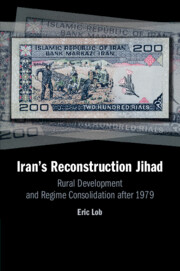Book contents
- Iran’s Reconstruction Jihad
- Iran’s Reconstruction Jihad
- Copyright page
- Contents
- Figures
- Tables
- Introduction
- 1 Inception (1962–1979)
- 2 Expansion (February 11–November 6, 1979)
- 3 Consolidation (1979–1989)
- 4 Demobilization and Institutionalization (1983–2001)
- 5 Disillusionment and Mobility (1983–2001)
- 6 Associationalism (1983–2013)
- 7 Africa (1985–2013)
- 8 Lebanon (1988–2013)
- 9 Jihadi Culture and Management (2005–2017)
- Conclusion
- Bibliography
- Index
Conclusion
Deconstructing Reconstruction Jihad
Published online by Cambridge University Press: 06 February 2020
- Iran’s Reconstruction Jihad
- Iran’s Reconstruction Jihad
- Copyright page
- Contents
- Figures
- Tables
- Introduction
- 1 Inception (1962–1979)
- 2 Expansion (February 11–November 6, 1979)
- 3 Consolidation (1979–1989)
- 4 Demobilization and Institutionalization (1983–2001)
- 5 Disillusionment and Mobility (1983–2001)
- 6 Associationalism (1983–2013)
- 7 Africa (1985–2013)
- 8 Lebanon (1988–2013)
- 9 Jihadi Culture and Management (2005–2017)
- Conclusion
- Bibliography
- Index
Summary
RJ demonstrates how the IRI instrumentalized rural development to consolidate power at home and project influence abroad. This book serves as a corrective and supplement to scholarly works that focus on the IRI’s consolidation and resilience mostly, if not entirely, in terms of repression, particularly in urban areas. Strategically and ideationally, RJ served as a soft-power mechanism that helped the IRI further bring provinces and villages into the political, economic, and sociocultural fold, and expand the state’s footprint in other parts of the Muslim and developing world. RJ’s organizational trajectory mirrored the IRI’s broader evolution during the last four decades. RJ sheds light on four important aspects of the IRI: first, the political and social changes and continuities that have transpired in Iran before the revolution until today; second, the ambiguity and reciprocity of the IRI’s state-society relations, and the agency or ability of its revolutionary activists to not simply follow and support leaders and officials, but also to influence and challenge them; third, the processes and outcomes behind the IRI’s centralization, consolidation, and state-building; and fourth and finally, the merits and shortcomings of the IRI’s bureaucratic institutionalization, and the opportunities and constraints of its associational life.
Keywords
- Type
- Chapter
- Information
- Iran's Reconstruction JihadRural Development and Regime Consolidation after 1979, pp. 335 - 348Publisher: Cambridge University PressPrint publication year: 2020

